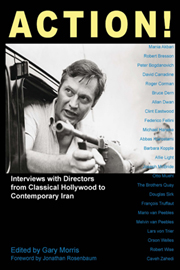Book contents
- Frontmatter
- Contents
- Foreword, by Jonathan Rosenbaum
- Editor's Preface
- Acknowledgements
- Introduction: The Art and Craft of Interviewing
- I Going Hollywood: Masters of Studio Style
- II Tickets to the Dark Side: Festival Favorites
- III Blows Against the Empire: Indie Godfathers
- IV Edgeplay: Avant-Garde Auteurs
- V Women in Revolt: Artist-Activists
- 14 Dialogues with Madwomen: Allie Light
- 15 Shut Up & Sing: Barbara Kopple
- VI The Canon: Brilliance without Borders
- Contributor Biographies
14 - Dialogues with Madwomen: Allie Light
from V - Women in Revolt: Artist-Activists
Published online by Cambridge University Press: 05 March 2012
- Frontmatter
- Contents
- Foreword, by Jonathan Rosenbaum
- Editor's Preface
- Acknowledgements
- Introduction: The Art and Craft of Interviewing
- I Going Hollywood: Masters of Studio Style
- II Tickets to the Dark Side: Festival Favorites
- III Blows Against the Empire: Indie Godfathers
- IV Edgeplay: Avant-Garde Auteurs
- V Women in Revolt: Artist-Activists
- 14 Dialogues with Madwomen: Allie Light
- 15 Shut Up & Sing: Barbara Kopple
- VI The Canon: Brilliance without Borders
- Contributor Biographies
Summary
The connection between mental illness and female articulation, assertiveness and creativity is one that society has nurtured. The idea that a woman who speaks her mind, acts in her own interests and–most significantly–openly expresses her sexuality must be insane goes back millennia, linked to the concept of “female hysteria” recorded by Plato and found even earlier in Egyptian papyri. Closer to home is the modern woman whose refusal or inability to conform to stifling social norms has resulted in her incarceration and abuse at the hands of family, church and the mental health industry who gain from the silence of women.
In Dialogues with Madwomen (1994), filmmakers Allie Light and her husband Irving Saraf have coaxed seven “madwomen” – including Light herself–into telling their stories. Using a mixture of home movies, archival footage of mental wards, reenactments and (mostly) interviews with their subjects, Light and Saraf have created a complex, moving portrait of women in whom depression, schizophrenia and multiple personalities coexist with powerful, sometimes inspired levels of creativity.
These women are often dazzling in their verbal facility, talking with honesty, humor and passion about the most intimate details of their lives. The first interviewee is director Light, who recalls the loss of interest in her domestic life that made her check herself into a hospital for treatment. She tells of her doctor's unusual attempts at behavior modification: “One weekend he told me I could go home if I promised to bake a turkey.
- Type
- Chapter
- Information
- Action! , pp. 227 - 234Publisher: Anthem PressPrint publication year: 2009

